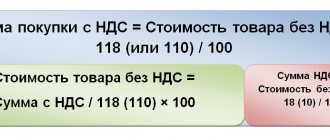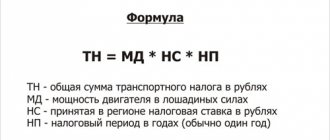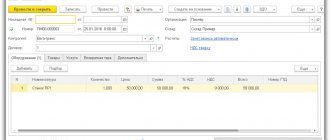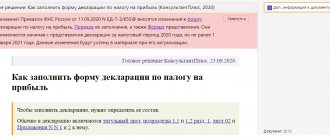How to calculate income tax
The tax period for income tax is one year. Therefore, the tax is calculated at the end of the year. However, during this period the company must pay advance payments.
The tax amount is calculated as follows:
Tax base x Tax rate.
The tax base is the profit for the reporting (tax) period. It is determined by the cumulative total from the beginning of the reporting (tax) period. The tax base is determined separately for the main tax rate and for each special rate.
At the same time, the Tax Code of the Russian Federation provides for the specifics of tax calculation in some cases, for example, companies with separate divisions calculate income tax according to special rules. There are nuances when calculating tax by newly created organizations.
Companies must pay their annual income tax to the budget no later than March 28 of the following year.
Advance payments are paid:
- based on the results of each quarter and monthly within this quarter;
- only based on the results of each quarter (advances are not paid within the quarter);
- at the end of each month, based on the actual profit received.
The procedure for calculating advance payments depends on the order of their payment.
What is tax accounting
Tax accounting is the process of summarizing information in order to determine the tax base for their calculation. This process is carried out on the basis of reporting and information in the organization’s primary documents, which must be maintained in accordance with the procedure defined by the State Tax Code.
Enterprise accounting system
The main purpose of this accounting is the constant formation of complete and correct information about the income and expenses of the organization to determine the tax base of the reporting period. Already on the basis of this data, accounting calculates and pays various taxes, and also analyzes indicators to optimize them and minimize tax risks.
Note! Maintaining this record is the responsibility of all enterprises operating in the country. The procedure for maintaining it at the enterprise must be enshrined in its accounting policies.
An organization can carry out tax accounting using one of the following options:
- Separate from accounting. This option is most suitable for large companies, where both types of accounting are usually maintained in different departments.
- Based on accounting. This option involves the maximum convergence of both types of accounting.
- Method for adjusting accounting data. The difference between both types is noticeable only in situations where deviations arise between them.
- Maintaining a tax accounting system in a special chart of accounts. Additional accounts are developed and entered into the working chart of accounts.
Determination of income when calculating tax
Income for the purposes of Chapter 25 of the Tax Code of the Russian Federation is an economic benefit received both in cash and in kind. Taxable income is divided into non-operating and income from sales.
At the same time, the code contains a closed list of income not subject to profit tax, which is given in Art. 251. These include, in particular, advances received, targeted financing, pledge or deposit and others.
The moment of recognition of income depends on the method of recognizing income and expenses that the taxpayer uses. So, if the company has chosen the accrual method, then income is recognized on the day of transfer of ownership upon the sale of property (except for real estate) or the date of transfer of the results of work performed, services provided, as well as property rights (clause 3 of Article 271 of the Tax Code of the Russian Federation).
Non-operating income is recognized depending on the type of income in the manner established in paragraph 4 of Art. 271 Tax Code of the Russian Federation.
If the organization uses the cash method, then income should be taken into account at the time of receipt of money or other property (clause 2 of Article 273 of the Tax Code of the Russian Federation).
Methods of accounting for income and expenses
The procedure for accounting for income and expenses in a particular period is determined by two methods:
- Accrual method
. Income and expenses are recognized in the period in which they were incurred, regardless of the date of payment and receipt of funds. - Cash method
. Income and expenses are recognized in the period in which expenses were paid or funds (property, property rights) were received. Organizations can apply this method provided that for the four previous quarters, revenue did not exceed one million for each quarter (in the amount of 4 million rubles for 4 quarters).
Note
: an organization can use only one of the specified methods; combination (for example, one method for income and another for expenses) is not allowed.
More details about the methods of accounting for income and expenses for income tax can be found in Art. 271-273 Tax Code of the Russian Federation.
Determination of income tax expenses
Expenses for profit tax purposes are expenses that meet the requirements of paragraph 1 of Art. 252 of the Tax Code of the Russian Federation, namely:
- economically justified and aimed at making a profit;
- documented.
An organization's expenses should be related to the nature of its activities, and not to profit. They are taken into account regardless of the presence or absence of income from sales in the tax period (letter of the Ministry of Finance of the Russian Federation dated December 28, 2017 No. 03-03-06/1/87897).
The Tax Code of the Russian Federation does not contain a specific list of documents that need to be used to confirm expenses. It is important that they make it clear what costs have been incurred. Documents confirming expenses must be drawn up in accordance with the requirements of domestic legislation or business customs on the territory of a foreign state, if expenses are incurred abroad (Clause 1 of Article 252 of the Tax Code of the Russian Federation). Expenses are confirmed by primary accounting documents, the forms of which are approved by the head of the company.
Expenses are divided into non-operating and expenses associated with production and sales. The list of the latter is enshrined in paragraph 1 of Art. 253 Tax Code of the Russian Federation. These include, among other things, the costs of manufacturing goods, their storage and delivery, and the maintenance of fixed assets. These costs can be direct and indirect. Direct ones are reflected for the purpose of calculating profit tax as goods, works or services are sold, and indirect ones are written off at a time in the current period.
The composition of non-operating expenses is prescribed in Art. 265 Tax Code of the Russian Federation. The code includes, for example, interest on loans, expenses for bank services, and legal expenses. That is, non-operating expenses are those expenses that are not directly related to the production or sale of goods, works, and services.
Please note: the Tax Code of the Russian Federation establishes a list of expenses that are not taken into account when taxing profits. It is enshrined in Art. 270 code. These include, for example, contributions to trade unions (Clause 20, Article 270 of the Tax Code of the Russian Federation).
Determination of revenue for accounting and tax purposes
It should be noted that the recognition by the Code of part of the listed receipts as income not taken into account for tax purposes does not affect the traditional procedure for reflecting these transactions in accounting accounts, but is rather of a formal reference nature, since when calculating the tax base for tax on profit such income is not taken into account.
Of particular note is the procedure for accounting for receipts in the form of prepayment
or
advances
for upcoming deliveries of products, goods, works and services. In accordance with PBU 9/99, these receipts are not recognized as income for accounting purposes, however, for tax purposes, such receipts are included in income not taken into account when determining the tax base only if the taxpayer determines income and expenses on an accrual basis. If an economic entity has the right to use the cash method of accounting for income and expenses for tax purposes, when the date of receipt of income is the day of receipt of funds in bank accounts, in the cash register of the enterprise, or receipt of other assets on account of revenue, then such amounts are included in income from the implementation of the reporting period.
This immediately raises the question: in what cases is it possible to use the cash method? In accounting, small enterprises have the right not to comply with the assumption of temporary certainty of the facts of economic activity and to use the cash method of accounting for income and expenses - according to the Standard Recommendations for the Organization of Accounting for Small Businesses (approved by Order of the Ministry of Finance of the Russian Federation dated December 21, 1998 N 64n). However, for the purposes of calculating income tax, the status of a small enterprise does not matter - according to the Tax Code, all organizations are required to recognize income in the reporting period in which they occurred, regardless of the actual receipt of funds or other property (Article 271 of the Tax Code of the Russian Federation). The right to recognize income for income tax purposes using the cash method is retained only by those organizations whose average amount of revenue from the sale of goods (work, services) over the previous four quarters, excluding VAT and sales tax, did not exceed one million rubles for each quarter (Article 273 of the Tax Code of the Russian Federation).
It should also be noted that the phrase 'revenue for tax purposes', which became common in previous years, has now become not entirely correct - from January 1, 2002, it is necessary to specify what kind of tax we are talking about, and, above all, the value added tax or about income tax. Previously, such a clause was not significant, since both for the purposes of calculating VAT and for income tax calculations, enterprises were required to choose a single procedure for recognizing sales revenue. This interpretation of the regulatory framework in force at that time was confirmed by letter of the Ministry of Finance of the Russian Federation dated March 24, 1999 N 04-03-03.
Currently, the mechanism for collecting these taxes is regulated by independent chapters of the Tax Code. At the same time, if there are strict restrictions on the use of the cash method for income tax, then Chapter 21 of the Tax Code, which determines the procedure for calculating and paying value added tax to the budget, allows business entities to independently choose the moment of VAT calculation.
At the same time, it should be borne in mind that even if the assumption of temporary certainty of the facts of economic activity is observed and the accrual method is used to account for income, differences in accounting and tax approaches remain.
Thus, in the general case, the reflection of income from ordinary activities in accounting is based on the requirements of the Accounting Regulations 'Income of the Organization' (PBU 9/99), which provides for a number of conditions that must be met to recognize revenue:
- firstly, the organization must have the right to receive revenue arising from a specific contract, or otherwise confirmed in an appropriate manner;
- secondly, the amount of revenue can be determined;
- thirdly, there must be confidence in the increase in economic benefits as a result of the transaction - the organization received assets in payment or there is no uncertainty regarding the receipt of assets;
- fourthly, the right of ownership (possession, use and disposal) of the product (goods) must pass to the buyer, the service must be provided, and the work must be accepted by the customer;
- fifthly, the expenses that have been or will be incurred in connection with this operation can be determined.
If at least one of the above conditions is not met in relation to cash and other assets received by the organization as payment, then accounts payable are recognized in the organization’s accounting records.
For the purposes of calculating income tax, the procedure for recognizing income using the accrual method is determined by Article 271 of the Tax Code of the Russian Federation. According to this article, for income from sales, unless otherwise provided by Chapter 25 of the Tax Code, the date of receipt of income is the day of shipment (transfer) of goods (work, services, property rights), while the day of shipment is considered the moment of sale, determined in accordance with paragraph 1 of Article 39 of the Tax Code of the Russian Federation, regardless of the actual receipt of funds (other property (work, services and (or) property rights) in payment for them. Commenting on Article 271 of the Tax Code of the Russian Federation, the Methodological Recommendations clarify that the day of sale of goods is the day of transfer of ownership, determined in accordance with civil law, while the day of implementation of the work corresponds to the date of the document confirming the transfer of the results of the work performed.
Thus, in the recognition of revenue for the purposes of accounting and calculation of corporate income tax, there may be a temporary gap when the ownership of sold products has already transferred, and the enterprise is obliged to include such income in the tax base, but any additional conditions for recognizing revenue according to PBU 9/99 and it cannot be included in income from ordinary activities.
Another aspect related to the moment of recognition of income from sales is the procedure for accounting for amount differences
. For accounting purposes, according to PBU 9/99, the amount of receipts is determined taking into account the amount differences that arise in cases where payment is made in rubles in an amount equivalent to the amount in foreign currency (conventional monetary units). The amount difference is understood as the difference between the ruble valuation of an asset actually received as revenue, expressed in foreign currency (conventional monetary units), calculated at the official or other agreed rate on the date of acceptance for accounting, and the ruble valuation of this asset, calculated at the official or other the agreed exchange rate on the date of recognition of revenue in accounting.
In the Tax Code, amount differences are defined in paragraph 7 of Article 271 of the Tax Code of the Russian Federation, where they mean the difference that arises for a taxpayer when the amount of obligations incurred in rubles, calculated according to the exchange rate of the relevant currency or conventional monetary units established by the legislation of the Russian Federation or by agreement of the parties, does not correspond actual amount received (paid) in Russian rubles. At the same time, taxpayers take into account the amount differences calculated in accordance with paragraph 7 of Article 271 when determining non-operating income
, and not as part of sales revenue. That is, if the taxpayer uses the accrual method, sales proceeds are recalculated into rubles at the time of transfer of ownership and its value does not subsequently change, and the adjustments made are included in non-operating income or expenses (depending on the type of adjustment) (Article 316 of the Tax Code of the Russian Federation ).
Differences in determining the volume of revenue affect not only the reflection of amount differences. In accounting, the amount of revenue from the fulfillment of obligations not in cash
, is accepted in accounting at the cost of goods (valuables) received or to be received, based on the price at which, in comparable circumstances, the organization usually determines the cost of similar goods (valuables). If it is impossible to determine the cost of goods (valuables) received, the amount of receipts or receivables is determined by the cost of products (goods) transferred or to be transferred by the organization, calculated on the basis of the price at which, in comparable circumstances, the organization usually determines revenue in relation to similar products.
Unlike accounting, for tax purposes (Article 274 of the Tax Code of the Russian Federation), income received in kind as a result of the sale of goods, work, services, property rights is taken into account based on the transaction price, taking into account the provisions of Article 40 of the Tax Code of the Russian Federation, which establishes general principles determining the price of goods, works and services for tax purposes.
Summarizing the above, we can conclude that sales revenue for the purposes of calculating corporate income tax may differ significantly from income from ordinary activities generated according to accounting rules.
Firstly, the Tax Code of the Russian Federation and PBU 9/99 provide for a different distribution of certain types of income between income from ordinary activities (income from sales) and other (non-operating) income.
Secondly, the requirements of accounting and tax legislation differ significantly in the procedure for determining revenue when using the accrual method and the rules for using the cash method of income recognition.
Thirdly, PBU 9/99 and the Tax Code have different approaches to determining the volume of revenue in cases of amount differences in non-cash settlements.
At first glance, not all of the above differences may affect the size of the tax base for income tax. Of course, failure to comply with the procedure for recognizing revenue for tax purposes will significantly distort the amount of taxable profit, while in cases where the list of included income differs, such an impact is not always obvious. Indeed, what is the difference between taking into account rental income as part of revenue or non-operating income, if they will still increase the tax base? Omitting the question of the correctness of filling out the income tax return, I would like to note that according to Chapter 25 of the Tax Code, sales proceeds are not only an integral part of the tax base, but also the basis for calculating some standardized expenses. In particular, according to Article 264 of the Tax Code of the Russian Federation, taxpayers’ expenses for the purchase (production) of prizes awarded to the winners of drawings of such prizes during mass advertising campaigns, as well as for other types of advertising carried out by them during the tax (reporting) period, for tax purposes are recognized in an amount not exceeding 1 percent of sales revenue. That is, an incorrect determination of revenue can affect not only the correct calculation of income, but also the amount of sales expenses, and, therefore, still distort the tax base for income tax.
Thus, when developing a tax accounting system for an enterprise and analyzing the similarities and differences between the rules of accounting and taxation, it is necessary not only to concentrate on the new mechanism for determining expenses, but to pay due attention to the procedure for calculating sales revenue.
______________
Write a letter to the author.
Copyright ї Yu. V. Shcherbinina, 2002 Copyright ї Website of Russian Taxpayers, 04/16/2002 — — — — — — — — — — — — — — — — — — — — — — — — — — — — — — — — — — — — — — — — — — — — — — — — Magazine 'Taxes and Payments'. Index 73869 according to the catalog 'Newspapers, magazines' (Rospechat). Subscribe at any post office. Internet subscription: www.nalogi.com.ru/Russia.html — — — — — — — — — — — — — — — — — — — — — — — — — — — — — — — — — — — — — — — — — — — — — — — —
Income tax rates
The basic rate for income tax is 20 percent (clause 1 of Article 284 of the Tax Code of the Russian Federation). This rate is divided into two parts:
- 3 percent goes to the federal budget;
- 17 percent go to the regional one.
In addition, the Tax Code of the Russian Federation provides preferential rates for certain incomes and certain categories of organizations.
Dividend rates:
- a zero tax rate applies to payments to a Russian organization that owns a 50 percent or higher stake in the authorized capital for 365 consecutive days;
- a rate of 13 percent applies to other Russian organizations;
- Dividends paid to foreign companies are taxed at a rate of 15 percent.
In relation to profits from the sale of a share in the authorized capital of a Russian organization that has been owned for more than 5 years, a 0 percent income tax rate is applied.
In addition, a zero rate for income tax is applied by agricultural producers, educational and medical organizations (Articles 284, 284.1 of the Tax Code of the Russian Federation).
Reduced rates may be established by regional law.
What income is not taken into account for tax purposes?
Receipts on which you do not need to pay income tax are addressed in Art. 251 Tax Code of the Russian Federation. Let us say right away that this list is exhaustive and is not subject to any expansions or additions.
The main non-taxable incomes are:
- contributions to the authorized capital, as well as contributions from owners to property in order to increase the company’s net assets;
Read about the latest innovations in this matter here.
- pledge, deposit, advances received;
See also “Should a security deposit be included in income?” .
- received loans and borrowings, etc.
Companies also have a lot of questions regarding these revenues. We answered the most common and acute of them in an article entirely devoted to Art. 251 Tax Code of the Russian Federation .
If new ones appear, we will definitely tell you about them. All you have to do is follow our publications.
Accounting for expenses using the cash method
The fact of payment is a key event in the cash method. Payment within the framework of recognition of expenses means the termination of a counter-obligation to the seller. The outflow of funds must necessarily be associated with goods, works or services purchased by the company.
When recognizing certain types of expenses, there are additional conditions. For example, for companies on OSNO, the costs of materials and raw materials can be taken into account only as they are sent to production. Depreciation can be taken into account only if the depreciable property is paid for and used in production. For simplified organizations, there is a restriction on accounting for expenses on goods for resale: such expenses are written off as products are sold.
When can an advance paid by a company to a counterparty be taken into account in expenses? Even if the company operates on a cash basis, such a payment cannot be recognized as an expense. Thus, in practice, prepayments to suppliers are recorded at the time of shipment of goods or provision of services/work.







